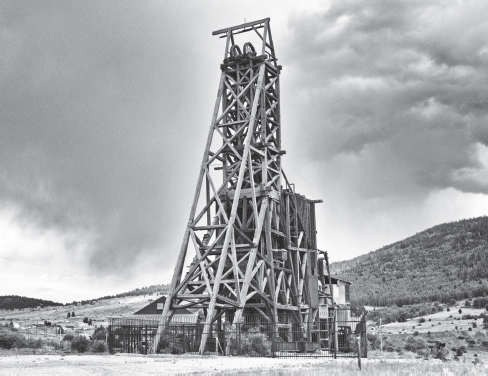
The headframe of William Stratton’s Independence gold mine on Battle Mountain. Courtesy of Tom Williams.
18
VICTOR
Winfield Scott Stratton could not believe his luck. He’d prospected all over Colorado since 1872, living on beans and hope. In 1891, he’d found some promising rocks on Battle Mountain and staked a claim, naming it the Independence, since he’d found it on the holiday. Stratton worked this claim sporadically for two years but discovered only a little gold. Disgusted, he decided to sell the worthless Independence in 1893, but the night before he was to finalize the sale, he accidentally discovered a rich vein of gold in a side tunnel. He estimated it would yield at least $1million in gold ore. Stratton carefully concealed the vein and spent a restless night worrying over a way to get out of the sale. The next day, the prospective buyer complained about the claim’s poor potential and asked if he could cancel their deal and get out of the purchase. Stratton could hardly believe his luck and readily agreed. He began working the Independence mine in earnest, and within just six months, Stratton was the mining district’s first millionaire.
Battle Mountain was overrun with prospectors when Frank and Harry Woods arrived from Illinois. They formed an investment company with their father and snapped up 136 acres at the foot of the mountain. They platted a town site, named it Victor, and began selling lots, claiming each would be a “gold mine.” Lots were quickly grabbed, and wood frame saloons, restaurants, stores, and homes were soon being hammered together.
The richest gold mines in the Cripple Creek Mining District—the Independence, the Portland, and the Ajax Mines—were all located on Battle Mountain. The steady stream of gold they produced helped Colorado recover from the terrible economic depression that followed the 1893 repeal of the Sherman Silver Purchase Act. Cripple Creek became a rich man’s town and was the social, financial, and political center of the mining district. Victor was known as “The City of Mines.” It was a working man’s town, the center of the rail and shipping district, and the home of the labor force that worked in the district’s five-hundred-plus gold mines.

The headframe of William Stratton’s Independence gold mine on Battle Mountain. Courtesy of Tom Williams.
Miners and their families lived in boardinghouses or clapboard and brick homes that crouched in the shadows of Battle Mountain’s skeletal head-frames and towering mine dumps. Daily underground blasts set the windows to rattling, and the dishes clattered as heavy ore wagons rumbled through the streets. Both the Florence & Cripple Creek Railroad and the Colorado Midland Railroad arrived in Victor in 1894. Just two years later, the population was around eighteen thousand, and there was an old saying that began, “Cripple Creek gets the glory, but Victor has the gold.”
The Woods boys completed their Victor Hotel and then founded the First National Bank, which was situated on the ground floor. Then they started the Pike’s Peak Power Company, the forerunner of today’s Southern Colorado Power Company. It supplied hydroelectric power to Victor, Cripple Creek, and even Pueblo.
Disaster struck on August 21, 1899, when a fire began in a Paradise Alley brothel. Within a few hours, the blazing inferno had consumed fourteen city blocks and about eight hundred buildings. Victor was destroyed—just a pile of ashes. There was $1.5 million in damages, and 1,500 people were homeless. The Woods brothers, the town’s largest property holders, suffered huge losses.
Victor’s citizens began rebuilding with bricks and stone, and within a few days, restaurants, shops, and saloons were back in business. The Woods brothers built the new four-story brick Victor Hotel and opened their First National Bank of Victor on the ground floor. Then they rebuilt the Gold Coin Club, an elegant clubhouse with a bowling alley, gymnasium, and library for their miners and other employees.
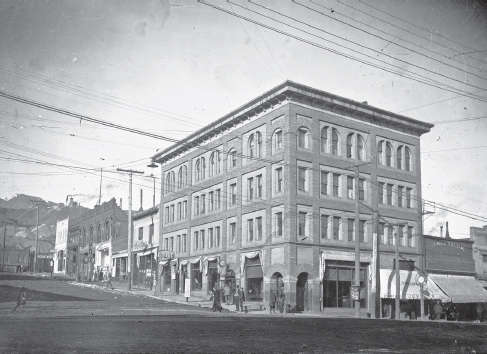
The Victor Hotel opened in 1900 and is in the National Register of Historic Places. Courtesy of History Colorado, Fred Mazzulla Collection.
Around the turn of the century, the eighteen thousand people living in Victor and the surrounding towns were served by three competing railroads. Railroad cars carrying gold ore headed down the mountains every day to the huge smelter at Colorado City and returned with their passenger cars full of businessmen and visitors.
By the fall of 1903, the Cripple Creek–Victor Mining District had become a hotbed of labor unrest. Victor was the stronghold of the Western Federation of Miners, a powerful union that was making its influence felt in mining districts throughout the West. Miners and mill workers demanded an eight-hour workday, and when the owners refused, strikes were called. Violence wracked the district as mines were dynamited, thirteen non-union mine workers were killed when dynamite exploded at a railroad depot, and many more people were injured. Governor Peabody called in the National Guard and declared martial law, and hundreds of union sympathizers were arrested by “lawmen,” who were really thugs hired by the mine owners. Two hundred union members were forced into railroad cars at gunpoint, hauled to the Colorado-Kansas border, dumped out, and ordered to never return. Gunshots were fired over the men’s heads as they ran pell-mell into unknown territory, leaving their families behind in Victor.
This illegal deportation of union miners continued unchecked until the miners voted to end their strike in August 1904. Some mine owners never recovered financially from the strike and didn’t resume mining operations. Working conditions didn’t improve, and wages remained the same.
Around 1907, a young Victor miner named Jack Dempsey had aspirations of becoming a world-class boxer. He worked in the mines by day and trained in the gym above the Victor City Hall at night. One of his first fights was at the Gold Coin Club on Christmas night 1907. He defeated “Kid Blacky,” starting his journey as the “Manassa Mauler,” and eventually became the world’s heavy-weight boxing champion in 1919.
The mine owners’ troubles escalated when the deep tunnels began filling with water from underground streams. They built large, expensive tunnels, but this did not resolve the drainage problems. Mines began closing because this gold had become too expensive to mine. Work slowed, and miners and merchants abandoned the small satellite towns surrounding Cripple Creek and Victor.
In 1914, Richard Roelofs, a civil engineer with little mining experience, made the district’s last great strike. He’d been working in the non-producing Cresson Mine for three years and had finally eked out $60,000 worth of gold ore. Then Roelofs discovered a “vug,” which is a sparkling cave within the earth. This golden cave was actually a huge geode, and it was worth a fortune! The cavern was forty feet high, twenty-three feet long, and thirteen and a half feet wide, and it was full of gold. Its walls were covered by gold crystals and flakes that were nearly an inch wide. Roelofs installed a solid steel door in the tunnel entrance and hired three armed guards to protect his treasure. In just one week, his miners had scraped $378,000 worth of gold from the walls. Within one month, this cave produced $1.2 million worth of gold—that’s over $20 million in today’s dollars.
The Cresson bonanza gave the mining district a brief reprieve, but the exodus of miners continued. In 1936, the City of Victor, facing bankruptcy, raised $5,000 for its coffers by processing the waste soil in front of the post office. This material had come from the abandoned tailings of the rich Gold Coin Mine. They’d been dumped because the mine didn’t bother processing any low-grade ore.
The Depression continued Victor’s downward economic spiral, and World War II brought the federal government’s mandate that mining could only be done to obtain “useful” minerals like copper, lead, and zinc for the war effort. Gold wasn’t to be mined. Most Victor mines were shut down, and houses were boarded up as people left. The few who remained behind spent their days sitting around on street benches or crowding around potbellied stoves reminiscing about “Victor’s good old days.”
Tourists began to drift through town during the 1950s, and some, attracted by Victor’s tumble-down buildings and forlorn appearance, stayed to paint pictures of the vacant streets, skeletal head-frames, and abandoned mines. In 1958, the Victor Museum opened, and in 1980, it was renamed the Lowell Thomas Museum, after one of the town’s illustrious citizens. Lowell Thomas’s father was a doctor who once had an office in the Victor Hotel. Lowell got his start delivering papers to Victor’s saloons and brothels and went on to become a famous journalist and radio and TV broadcaster. Lowell Thomas was awarded the Medal of Freedom by President Ford in 1976. He traveled the world, and memorabilia from Thomas’s long, illustrious career can be seen at the museum in the old office of the Victor Record.
Victor has about three hundred year-round residents now, and the Victor Downtown Historic District includes fifty-five of its sixty-six buildings. Many of these Neo-classical buildings are listed in the National Register of Historic Places, and Victor is a National Historic District.
In 1962, the Ajax Mine, which outlived all the others, stopped its operations after producing over $20 million in gold. Everyone thought this was the end of mining in the district, but when the price of gold began to go up in the 1980s, major mining companies became interested in Victor once again. Today, the Cripple Creek and Victor Gold Mining Company operates an open pit and leaching mine at the Cresson Mine, the largest in Colorado. It produces gold every year. The Cripple Creek–Victor Mining District has mined more gold than the California and Alaska gold rushes combined, and there’s still a lot more, deep within the mountains.
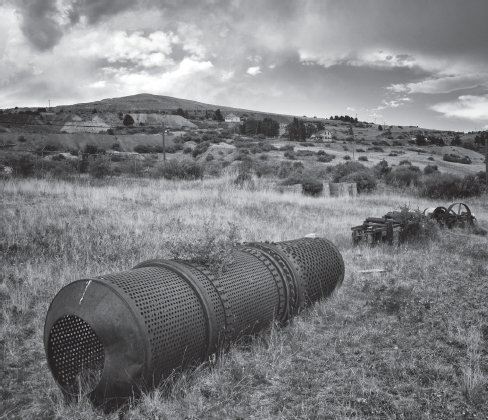
The San Juan Mountains are dotted with abandoned camps, old mines, and mining equipment. Courtesy of Tom Williams.
VICTOR HOTEL
Frank and Harry Woods struck it rich right away. They’d made money selling land, and now they were going to build Victor’s first hotel. They had just started excavating the foundation when they struck gold, a twenty-inch-wide vein of the glittering stuff. They started mining immediately, and within a short time, the tall head-frame of their Gold Coin Mine dominated Main Street.
The brothers found another site for Victor’s first hotel and built a three-story frame building that opened in July 1894. Five years later, it burned to the ground in the August 1899 fire, which caused $1.5 million in damages. The Woods Investment Company had become Victor’s largest property owner and suffered the heaviest losses, including the total destruction of the bank and hotel. Frank and Harry shrugged off their losses because their Gold Coin Mine was bringing in as much as $50,000 a month.
They began building a new hotel, a four-story brick structure that took up most of a block on Victor Avenue. The Woods’s First National Bank of Victor was on the ground floor, and a birdcage elevator carried lawyers, engineers, and businessmen to their offices on the second and third floors. Hotel rooms on the fourth floor rented for $2.50 per day, with a bath down the hall. The hotel’s grand opening was on Christmas Eve 1899, and crowds gathered to admire the fancy Victorian wallpaper, fine furnishings, and pressed-metal ceilings.
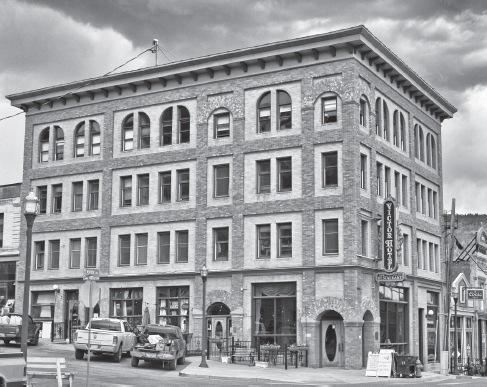
The Victor Hotel is a Colorado Landmark Hotel and is included in the National Register of Historic Places. Courtesy of Tom Williams.
The Woods brothers had become immensely wealthy, and they had extensive real estate holdings, with assets of over $40 million, but their luck was changed by the 1899 fire. They lost many properties, and profits from the Gold Coin Mine, which had produced over $6 million, began to decline. Rumors of their financial troubles caused a run on their bank, and creditors circled as they tried to consolidate their holdings. Bank auditors declared their First National Bank insolvent and closed its doors. A grocery and jewelry store took over the first floor, and in 1904 A.E. Carlton, a wealthy mine owner, bought the entire Cripple Creek Mining District, plus the Victor Hotel. He established the City Bank on its first floor, retained the offices on the second and third floors, and converted the fourth floor into a hospital. In 1917, Carlton sold the bank to R.J. Gardner, who changed the bank’s name to the Citizen’s Bank of Victor. It operated briefly and was forced to close during the Depression. During this period, the small hospital was also closed, and the patients were moved to the St. Nicholas Hospital in Cripple Creek.
After the Woods brothers’ financial empire collapsed, Harry moved to California and lived modestly until his death in 1928. Frank’s son was killed in a mining accident in Colorado, and then both his wife and daughter died. He eventually remarried, but his second wife died, too. Frank tried several new business ventures, all of which failed. He moved to California, and when he died in 1932, his friends had to take up a collection for his burial.
The hotel building changed hands several times, and a variety of enterprises leased space there. A gift shop, restaurant, and soda fountain did business on the building’s first floor during the 1950s, but the entire building was closed in the late 1960s. For the next twenty years, the Victor Hotel building sat vacant and deteriorating. In 1991, it was purchased in by the Victor Hotel Limited Liability Company.
After a $1 million renovation, the Victor Hotel reopened with its original bank vault and birdcage elevator in the Victorian lobby. Many historic elements of the old building were maintained but were updated to meet current building codes. The steam radiators were refurbished and fitted with individual thermostats in the rooms, while the ornate woodwork was refinished. The twelve-foot-high plate-glass windows, which are more than a century old, are still intact, and the original pressed-metal ceilings were cleaned and polished until they gleamed. Private baths were installed in the twenty guest rooms. The hotel, which looks much as it did in 1899, was placed on the National Register of Historic Places in 1980, and it is a Colorado Landmark Hotel.
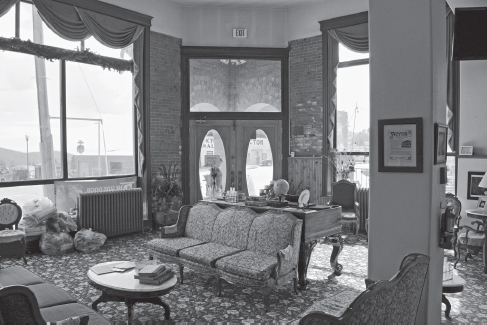
The City Bank was located on the first floor of the Victor Hotel. Courtesy of Tom Williams.
GHOSTS
Many colorful characters have made the Victor Hotel their headquarters, and the old safe in the lobby once held millions of dollars in gold and currency. The Woods brothers made many huge investments, and high-powered mining executives and wealthy financiers often structured deals in their office. Now shadows of the hotel’s glittering past linger in the halls, while restless spirits slip about, casting mysterious spells and whispering secrets. Guests have seen misty shapes and heard footsteps and laughter when no one’s around. Sudden cold drafts, unexplained voices, and noises occasionally disturb the twilight hours.
The antique birdcage elevator still runs up and down between floors, taking guests to their rooms, and sometimes its passengers can’t even be seen. Eddie McDermott worked in the mines in the early 1900s and boarded in room 301. He left for work every morning around 3:00 a.m., always taking the elevator to the lobby. One morning, Eddie pushed the button and called the elevator to the third floor. The doors opened, Eddie stepped in—and fell to his death, tumbling down the elevator shaft. There was no explanation for the tragedy, and Eddie’s friends gathered in his room to mourn and toast his memory.
Guests in room 301 sometimes hear heavy footsteps in the hall stop outside their door, but there’s never anyone there. Employees and guests have seen an older man in a flannel shirt and hat standing near room 301 or fiddling around with the elevator buttons.
A former hotel manager said a geology professor who stayed in room 301 for several days complained that he was often awakened by loud tapping noises coming from the radiator. One night, he awoke to see an older man tapping on the steam radiator, and then he slowly disappeared.
Guests in room 307 often complain that someone is banging on the pipes and that this clanking racket keeps them awake. There are no pipes in the walls that are near this room, and the noise can’t be explained.
The apparition of an attractive young woman has been seen around the hotel by guests and employees. During the 2003 holiday season, she often passed through the lobby, stopping to admire the festive decorations, and then she simply vanished.
During the years when the fourth floor served as a hospital, injured miners were treated here. Some survived—some didn’t. In the winter, when the ground was frozen, the bodies of the dead were kept in the hospital’s morgue until the ground thawed enough in the spring for their burial. Many employees have reported seeing apparitions drifting through the fourth-floor halls, and voices have been heard when no one is around. Some shadowy forms seem to be missing an arm or a leg.
The Victor Hotel has been investigated by Mountain Peak Paranormal Investigations, Graves Paranormal Investigations and Research, and Colorado Paranormal Investigations. When Rocky Mountain Paranormal Investigations spent the night at the hotel, one member of the group made a recording of a hoarse voice that whispered, “Who are you?” Another investigator who stayed in 301, Eddie’s room, heard a similar voice.
A couple from the Netherlands complained that they couldn’t sleep in their room, 301, “because there was so much electricity in it.” The lights and TV kept flickering on and off, and they were awakened by the sound of footsteps near the bed. When the light was flicked on, no one was there. The couple asked to be moved, but there were no other vacant rooms available. Determined to make the best of their situation, they tried to get some sleep again. The man had just managed to drift off when he awakened suddenly to see a misty figure standing at the foot of the bed. As he watched, terrified, the image slowly faded away. The remainder of the night, the couple was just too anxious to sleep, and they spent some more restless hours listening to the old elevator rattle up and down.